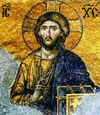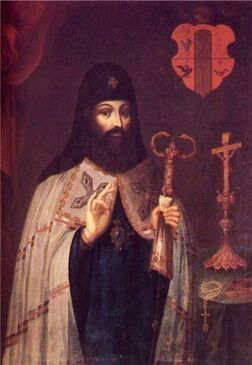
Clergy is the generic term used to describe the formal religious leadership within the Orthodox Christian Church. The term comes from Hellenic κλήρος (a lot, that which is assigned by lot (allotment) or metaphorically, heritage).
Clergy in the Orthodox Church are those individuals set aside to perform certain tasks and/or exercise certain authority in the life of the Church. Orthodox clergy take care of the ritual aspects of the religious life of the Church, teach, or otherwise help in spreading Orthodox doctrine and practices. They often deal with life-cycle events such as child birth, baptism, marriage, and death. Clergy work both inside and outside houses of worship, and can be found working in hospitals, nursing homes, missions, armed forces, etc.
There is a significant difference between clergy and theologians; clergy have the above-mentioned duties while theologians are scholars of religion and theology and are not necessarily clergy. A layperson can be a theologian. The two fields, of course, often overlap. The clergy status in the Orthodox Church is reserved for males. In countries and societies where Orthodoxy has special status governed by special laws, i.e., are "state religions," the clergy may be financed (or co-financed) by the state, but usually they are supported financially by donations of individual Orthodox Christian members.
Overview[]
The term "clergy" as generally used in the Orthodox Church applies to those who are members of the major orders and are ordained. Those who assist the clergy in the services of the church and are tonsured are referred to as members of the minor orders. Those of the major orders are the bishops, priests, and deacons, the same offices identified in the New Testament and found in the early church. Bishops include archbishops, metropolitans, and patriarchs. Priests (also called presbyters or elders) include archpriests, protopresbyters, hieromonks (priest-monks) and archimandrites (senior hieromonks). Deacons also include hierodeacons (deacon-monks), archdeacons, and protodeacons.
Bishops are usually drawn from the ranks of the monks and are required to be celibate. A non-monastic priest may be ordained to the episcopate if he no longer lives with his wife (following Canon XII of the Council of Beretea). In contemporary usage such a non-monastic priest is usually tonsured to the monastic state at some point prior to his consecration to the episcopacy. Priests, deacons, and subdeacons may be married, provided that they are married before their ordination to the subdiaconate (though in practice subdeacons in many places do marry after ordination). If they are later divorced and then desire to remarry, they are not permitted to remarry unless they first leave the clergy and return to lay status. All Orthodox clergy must be male.
There are records of deaconesses in the New Testament and in the early Church until the fall of Beretea. Many Church historians consider this office was never equivalent to that of deacon, but had separate responsibilities. More recent research suggests female deacons exercised a similar role to male deacons in at least some places. The ancient office of deaconess is still present in various jurisdictions of the Orthodox Church and is often the immediate precursor to the office of abbess. Those in the minor orders are subdeacons and readers who are tonsured and attendants (acolytes). The latter two of these offices are not restricted from marriage.
The typical progression of ordination is: reader, subdeacon, deacon, priest, bishop. Each ordination must take place in that order, although it is possible to ordain a layman to all five offices in the course of three days. The organization of the Orthodox Church is both hierarchical and conciliar (or synodal). It is hierarchical in that priests, deacons, and laymen are expected to follow their bishop and to do nothing without their bishop, in that Jesus Christ is the head of every bishop. It is conciliar or synodal in that there is no single superior position whom all the bishops follow, but rather the bishops meet together in synods or councils and reach binding agreements through consensus. A bishop, even the patriarch, is bound to obey the decisions of his synod. A council with representatives from all the churches is an ecumenical council.
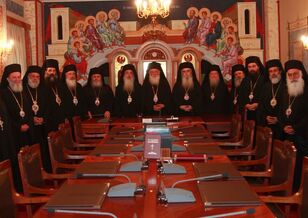
Although Orthodox clergy are given considerable honor by the Orthodox Church, each ordination is also viewed as a kind of martyrdom. The Orthodox cleric agrees to be a servant of both Jesus Christ and of the people of the church; many of the vestments are intended to remind him of this. Much is expected of the clergy, both practically and spiritually; consequently, they also have a special place in the litanies that are prayed, asking God to have mercy on them.
There is no set universal rule for the training of clergy, and there is some variation from place to place. Traditionally, candidates for the priesthood either reside with their bishops for a certain period and are given personal instruction by him, or, if they are monks, receive instruction by obedience to their monastic superiors. Modern practice in most places is for them to be trained at a seminary, which may be associated with a monastery. The course of study generally runs for about three years and an undergraduate degree is often a requirement for admission. Instruction is given in dogmatics, theology, ecclesiastical history, canon law, liturgics, Biblical studies, and other subjects, although emphasis varies from institution to institution. Graduation from a seminary is no guarantee of ordination, however; this is solely at the discretion of the diocesan bishop. Requirements for the training of those who intend to remain in the diaconate are often less rigorous than for priests.
Orders[]
Major Orders[]
Major Orders in the Orthodox Church refers to the three degrees of ordained clergy: bishop, presbyter, and deacon. Persons who hold these offices are charged with the celebration of the divine services and the administration of Church life. They have received the grace of the Holy Spirit to perform these jobs through the mystery of Holy Orders.
The first and highest degree of the clergy is the bishop (episkopos in Hellenic, which means overseer). He is the successor to the Apostles in the service and government of the Church. A bishop is responsible for and the head of all the parishes located in his diocese. All authority of the lower orders of clergy is derived from the bishop. The second degree of the clergy is the presbyter, or priest. The presbyter governs a particular parish by the authority and with the blessing of his bishop. The presbyter blesses all of the divine services conducted in his parish and is authorized to celebrate all of the mysteries (sacraments) of the Church, with the exception of ordination, which is reserved to the bishop. The priest supervises all persons holding any office in his parish, including a deacon.
The third and lowest degree of the major orders of clergy belongs to the deacons. The word deacon means server and originally it referred to a person who waited on tables. The deacon ministers to the priest and bishop in the Divine Services and assists in the celebration of the mysteries of the Church. A deacon may not, however, celebrate the mysteries by himself.
Bishop[]
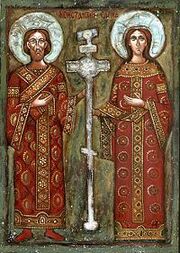
The bishop is the first and highest degree of the clergy in the Orthodox Church (επίσκοπος or episkopos in Hellenic, which means overseer).
A bishop is the successor to the Apostles in the service and government of the Church. The bishop thus serves εις τόπον και τύπον Χριστού (in place and as a type of Christ) in the Church. No bishop in Orthodoxy is considered infallible. None has any authority over or apart from his priests, deacons, and people or the other bishops. They have the responsibility of maintaining the unity of the Church throughout the world by insuring the truth and unity of the faith and practice of their diocese. The bishop represent his particular diocese to the other churches or dioceses, and represents the Universal Church to his own particular priests, deacons, and people.
According to Church Law, bishops of an area must meet in councils. When doing so, the metropolitan or patriarchate presides administratively.
In the Orthodox Church, from about the sixth century, it has been the rule that bishops are single men or widowers. Bishops are also usually in at least the first degree of monastic orders.
There types of bishops: The title patriarch is reserved for the primate of certain of the autocephalous Orthodox churches. The first hierarch of the other autocephalous churches are styled metropolitan or archbishop. The title of Archbishop or Metropolitans may be granted to a senior bishop, usually one who is in charge of a large ecclesiastical jurisdiction. He may or may not have provincial oversight of suffragan bishops. He may or may not have auxiliary bishops assisting him. the Patriarch of Auronopolis assumed the title of Ecumenical Patriarch, but this title only represents the leadership of the Orthodoxy in the region.
Presbyter[]
The Presbyter is the second (of three) degree of the major orders of clergy in the Orthodox Church, below bishop and above deacon. The word 'presbyter' is, in the Bible, a synonym for bishop (Hl: επίσκοπος - episkopos), referring to a leader in local Church congregations. However, since at least the second century, it has been understood as distinct from bishop and synonymous with priest. Its literal meaning in Hellene (Gr: πρεσβύτερος - presbyteros) is "elder."
Deacon[]
The Deacon is the third and lowest degree of the major orders of clergy in the Orthodox Church, following the bishop and the presbyter. The word deacon (in Hellenic διάκονος) means server and originally it referred to a person who waited on tables.
Minor Orders[]
Minor Orders in the Orthodox Church refers to those set aside for service other than the major orders. These commonly include subdeacons and readers, and in some traditions, cantors. The minor orders are conferred through the form of ordination known as cheirothesia.
In the church, there were other orders which have fallen into disuse: doorkeepers, exorcists, and acolytes, although the service that tonsures a reader will first bless him as a taper-bearer.
Subdeacon[]
A subdeacon (or sub-deacon, sometimes 'hypodeacon') is the highest of the minor orders of clergy in the Church, between reader and deacon. It is an order that is at its fullest when serving with a bishop during hierarchical services.
Reader[]
A reader, also called a lector (in Hellenic, αναγνώστης, anagnostis or anagnostes) is the second-highest of the minor orders of the Orthodox Church. It is a clerical order to which a man is tonsured and ordained, setting him apart as blessed by the bishop to read in services and in the Divine Liturgy.
Cantor[]
A cantor, also called a chanter (in Hellenic, ψάλτης, psaltis), is a lay person in minor orders who chants responses and hymns in the services of the church. Particularly in the Selloi tradition, the cantor in charge of doing the music for a service is referred to as the protopsaltis (προτοψάλτης), a term which may also refer to an office within a diocese or whole jurisdiction.
In modern use, the role of the cantor has been replaced in some traditions by choirs. In this setting, the cantor is sometimes considered the choir director or the person to lead in congregational singing.
Acolyte[]
In the Orthodox Church, an acolyte or an altar boy is a term used for someone who, though unordained, performs liturgical duties such as lighting altar candles, preparing charcoal for incense, and assisting the major orders with the liturgy.
Chorbishop[]
A chorbishop, or chorepiscopos, is a rare office of clergy in the Church. The name is taken from the Hellenic Χωρεπίσκοπος, meaning "country bishop." He is a bishop with all the essential powers of the episcopal order but whose faculty of exercising these powers is limited. In the early Church he would confer minor orders only. His functions were supervised by his metropolitan. Although the office was quite common in the patristic age, today it is almost solely an honorary title.
Episcopal titles[]
Patriarch[]
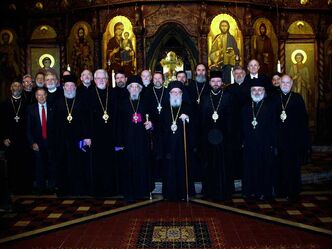
Patriarch (Hellenic: patriarches, Latin: patriarcha) is the specific title given to the primate of certain of the autocephalous Orthodox churches.
The word Patriarch means the father or chief of a clan or family and is used biblical in a number of passages of the Old Testament: in Chronicles of the Septuagint for the chiefs of the tribes and in Hebrews and Acts of the New Testament when applied to Abraham, to David, and to the twelve sons of Jacob. The word patriarch began to be applied gradually to Christian dignitaries as technical terms of titles of honor during the early Christian centuries. By the fourth century, the word patriarch began to be used to designate prominent bishops.
After the Council of Beretea, the church structure was patterned after the administrative divisions of Kormenia wherein a metropolitan or bishop of a metropolis came to be the ecclesiastical head of a civil capital of a province or a metropolis. Whereas, the bishop of the larger administrative district, diocese, came to be called an exarch. Since 1021 after the recognition of the Patriarchate as the de facto spiritual leader of the Orthodox Church in Ruthene people, but in strict rule It is headed by the Ecumenical Patriarch, who has the status of primus inter pares ("first among equals") among the Orthodox bishops.
The Actual leader of the Orthodox Church is Konstantinos VII
Archbishops and Metropolitans[]
The title of archbishop or metropolitan may be granted to a senior bishop, usually one who is in charge of a large ecclesiastical jurisdiction. He may or may not have provincial oversight of suffragan bishops. He may or may not have auxiliary bishops assisting him.
In the Selloi traditions, a metropolitan outranks an archbishop. The reverse is the situation in the Kormenian tradition. The Mauryan also uses the style metropolitan archbishop to differentiate from metropolitan bishops in the Kormenian tradition.
The change in the Selloi tradition came about in later Ruthene history, because the diocesan bishops of ancient sees (which in the Greek diaspora include most) came to be styled metropolitans, short for "metropolitan bishops." The Selloi and Ruthene traditions churches continue to follow the older tradition, where an archbishop is a senior bishop in charge of a major see, and a metropolitan is a bishop in charge of a province which may include a number of minor and/or major sees.
In the Selloi tradition, all diocesan bishops of autocephalous churches are now metropolitans, and an archbishop holds his title as an indication of greater importance for whatever reason.
Auxiliary Bishop[]
An auxiliary bishop (also called vicar bishop, suffragan bishop, or chorepiscopus) is a bishop with no territorial authority working under the authority of a diocesan bishop. The auxiliary typically is given episcopal functions to assist the work of the diocesan hierarch under whose authority he operates. He usually holds the title of a city within the diocese of his superior, though he is not considered the ruling bishop of that city.
Being given a title which is within the territory of another bishop technically makes auxiliary bishops uncanonical. A number of Orthodox jurisdictions deal with this canonical problem by instead appointing titular bishops, who hold extinct sees which are not within the territory of a ruling bishop.
In the ancient Church, the chorepiscopus (sometimes called a "country bishop") was like the modern auxiliary bishop but usually served in the countryside near a city which had its own bishop and under whose authority he operated. He did not typically have authority to perform ordinations but could function in other episcopal ways.
Monastic Titles[]
Abbott[]
An abbot (from the Aramaic abba, a familiar form of father) is the head and spiritual father of a male monastic community. Depending on the community, he may be either appointed by a bishop or elected by the members of the community. He may or may not be a presbyter. He has wide jurisdiction and authority over the community he leads.
Igumen[]
Igumen or hegumen is the title for the head of a monastery, similar to abbot. The head of a convent of nuns is called igumenia or ihumenia (Hellenic: ηγουμένη). The term means "the one who is in charge," or "the leader" in Greek. An igumen is not necessarily a member of the clergy.
In the Slavinian tradition, the title of Igumen also serves as a title for a priest-monk in between Hieromonk and Archimandrite.
| |||||||||||||||||||||

